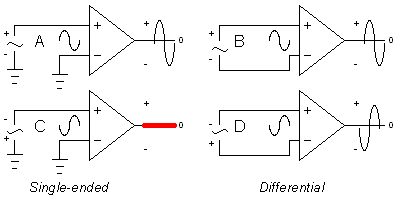There is a persistent quandary out there concerning the difference between single-ended and differential analog input configurations. Specifically, many have the impression that analog inputs configured to be single-ended cannot measure negative-going voltages inputs. I’m not sure where or how this rumor got started, but it’s pervasive and has led many an end-user astray.
Here’s an example. The following is drawn word-for-word from a recent customer email who had purchased one of our DI-718B data loggers with several DI-8B41-09 amplifiers:
I’m a bit puzzled regarding the SE inputs. According to the datasheet the input modules convert a ±40 V to a ±5 V signal. Might it be that the DI-718B actually offsets the signal by 5V and the reads the signal as 0-10V??
It may not be obvious, but experience screams that this customer was under the impression that negative going signals cannot be measured by single-ended (SE) inputs. Hence, he thought that before the logger’s single-ended input could make the measurement it would need to apply a +5 V offset to the amplifier’s output to yield a signal in the range of 0-10 V, suitably denuded of any negative components.
When we replied that single-ended inputs can measure signals less than zero, and after the customer proved this to himself through experimentation, the issue was resolved.
So, what’s the difference between SE and differential input configurations? The nearby figure shows four signal configurations, two each for differential and single-ended. The signal is a common sine wave of the type you’d get from a function generator.  Configuration A and B show that the polarity of the signal generator is connected to match the polarity of the input amplifier, “+” to “+” and “-” to “-.” Notice that the SE configuration has no problem duplicating the negative portion of the sine wave as does its differential counterpart. However, in configurations C and D where we swap the polarity of the input signal generator versus the amplifier, “+” to “-” and “-” to “+”, we have a problem. Since by definition the low side of the SE amplifier is connected to ground, swapping the polarity of the input signal essentially shorts the “+” output of the generator to ground causing the amplifier’s output to show no activity other than zero volts. However, the differential configuration of D simply swaps the polarity of the sine wave to show an inverted sine wave at its output, which is precisely consistent with the polarity of the input signal.
Configuration A and B show that the polarity of the signal generator is connected to match the polarity of the input amplifier, “+” to “+” and “-” to “-.” Notice that the SE configuration has no problem duplicating the negative portion of the sine wave as does its differential counterpart. However, in configurations C and D where we swap the polarity of the input signal generator versus the amplifier, “+” to “-” and “-” to “+”, we have a problem. Since by definition the low side of the SE amplifier is connected to ground, swapping the polarity of the input signal essentially shorts the “+” output of the generator to ground causing the amplifier’s output to show no activity other than zero volts. However, the differential configuration of D simply swaps the polarity of the sine wave to show an inverted sine wave at its output, which is precisely consistent with the polarity of the input signal.
Single-ended input configurations suffer at least one disadvantage when compared to its differential counterpart, but the inability to handle signal levels less than zero is not one of them.


 View Cart
View Cart sales@dataq.com
sales@dataq.com 330-668-1444
330-668-1444